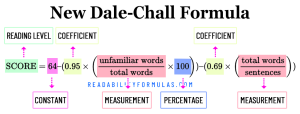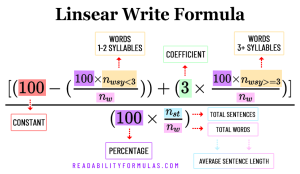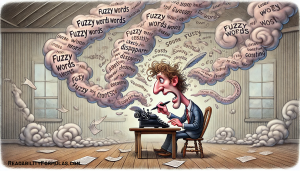 Ever felt like you were reading something written in another language even though it was English? You’re not alone. Readability formulas are the unsung heroes behind making sure you’re not lost in translation. Here’s why.
Ever felt like you were reading something written in another language even though it was English? You’re not alone. Readability formulas are the unsung heroes behind making sure you’re not lost in translation. Here’s why.
Despite their much-criticized shortcomings, many writers and non-writers rely on readability formulas to evaluate text for complexity and wordiness.
According to the National Center for Education Statistics (NCES), 21% of adults in the U.S. read below a 5th-grade level, and only 48% have proficient literacy skills. This underscores why you need to tailor your content to a wide range of reading skills.
1. Picture this—your readers are on a journey, and your words are their roadmap. But not every reader is equipped for a complicated trek. Some readers might struggle with complex language. Other readers might struggle with sentences over 21 words. Most American adults have limited reading ability: their reading grade-level is between average (8th grade) and poor (5th grade). It makes sense to prepare text in plain English if your readers have limited reading skills. This is where readability formulas swoop in to save the day—they can help you write text that fits just right.
Research by the Society for Human Resource Management (SHRM) suggests that companies with effective communication practices return 47% more profits to shareholders. Using readability formulas can help improve written communications within businesses.
2. If the text is not readable, you defeat the purpose of writing it in the first place. For instance, let’s assume you’ve written an instruction manual for your employees. If your employees cannot read this manual, they can’t understand the true meaning of its contents; this will adversely impact their productivity. Using readability formulas can prevent such a scenario and tell you beforehand if your employees can understand your instructions.
A study by the University of California found the average office worker spends 2.5 hours per day reading emails, memos, and other documents. Ensuring your text is readable can decrease the time spent on deciphering it and therefore increase productivity.
3. These formulas can save you time and money that you might have wasted in writing a complicated document, which is not useful for the target audience.
A study by the College Board’s National Commission on Writing estimates that blue-chip businesses spend as much as $3.1 billion on remedial writing training annually. Effective use of readability formulas can reduce this expenditure by ensuring final drafts of texts are readable.
4. Just imagine how frustrated your target audience feels trying to read an ill-prepared document. Studies show that enforcing difficult text can have adverse effects on the overall mood and psychology of your customers. They may feel confused by a clumsily prepared text and opt for another provider.
5. Preparing text costs money. If you produce an unreadable text, you are increasing your organization’s operating costs. By using readability formulas, you are almost 80% sure that your readers find your text useful; thereby, keeping your costs down.
A report by Renaissance Learning showed that students who read age-appropriate, engaging texts achieved 2.4 times more growth in reading skills than their peers who did not. Readability formulas can aid in matching reading materials with student abilities.
6. We live in an age of convenience. Your favorite word-processor, whether it’s MS-Word or another, likely has readability tools built right in. It’s like having a skilled mentor standing by, ready to advise. And if it’s there, just a click away, why not use it?
7. Consider the global audience: With digital content more dominate these days, your words aren’t confined to your workspace. Your words reach the ends of the Earth. And what’s music to your ears might be noise to someone else. Readability formulas enable you to harmonize your message for different audiences.
English is a second language for around 375 million people. Crafting your business documents with the help of readability formulas ensures you reach non-native speakers more effectively, opening new markets and opportunities.
8. Regulatory compliance: Legal and health documents must meet specific readability standards. Falling short could cost you—not just the trust of your readers, but could land you in legal trouble. Readability formulas act as the guardrails on the highway of compliance.
9. Marketing impact: A brilliant marketing message lost in translation is like a lamp hidden under a bushel. Readability formulas light the path to crafting messages that shine bright. They help convert prospects into clients, and readers into fans.
Good: An advertisement that speaks in the language of the consumer.
Bad: A product description filled with industry jargon that confuses potential customers.
10. Improve educational materials: Teachers and educational content developers must strike the right chord with students. Readability formulas are the tuning forks, ensuring the content sings at the right pitch for each grade level.
A study by the Educational Testing Service (ETS) found that students’ reading levels can significantly affect their academic success. When students can easily understand the material, they can retain information and improve academically.
11. User manuals and instructions: Think of assembling a piece of furniture with instructions that feel like a cryptic puzzle. Readability formulas help turn those riddles into clear steps.
Good: A user manual with clear, concise instructions.
Bad: Assembly guidelines filled with technical terms and unclear steps.
12. It’s about empathy: Putting yourself in the reader’s shoes, feeling their pulse, understanding their pace. That’s what readability formulas allow you to do.
13. They’re continuously evolving: Readability formulas aren’t set in stone; they adapt, change, and grow just like language itself. AI technologies are advancing existing algorithms to understand the nuances better and help craft text that’s a living, breathing entity.
14. Accessibility to all: Readability is not just about education or marketing; it’s about inclusivity. Readability formulas allow you to reach people with reading disabilities, providing content that’s accessible to all.
Good: Adapting texts to be readable for individuals with dyslexia or other reading challenges.
Bad: Ignoring the diverse needs of readers and losing the opportunity to connect.
Readability formulas aren’t just tools; they are guides, advisers, even psychologists of the written word. They help you engage with your readers—they turn the words on a page into connections and understanding. Isn’t it time to embrace them and make every word count?
Scott, Brian. “Why Use Readability Formulas?.” ReadabilityFormulas.com, 17 Nov. 2024, https://readabilityformulas.com/why-use-readability-formulas/.







